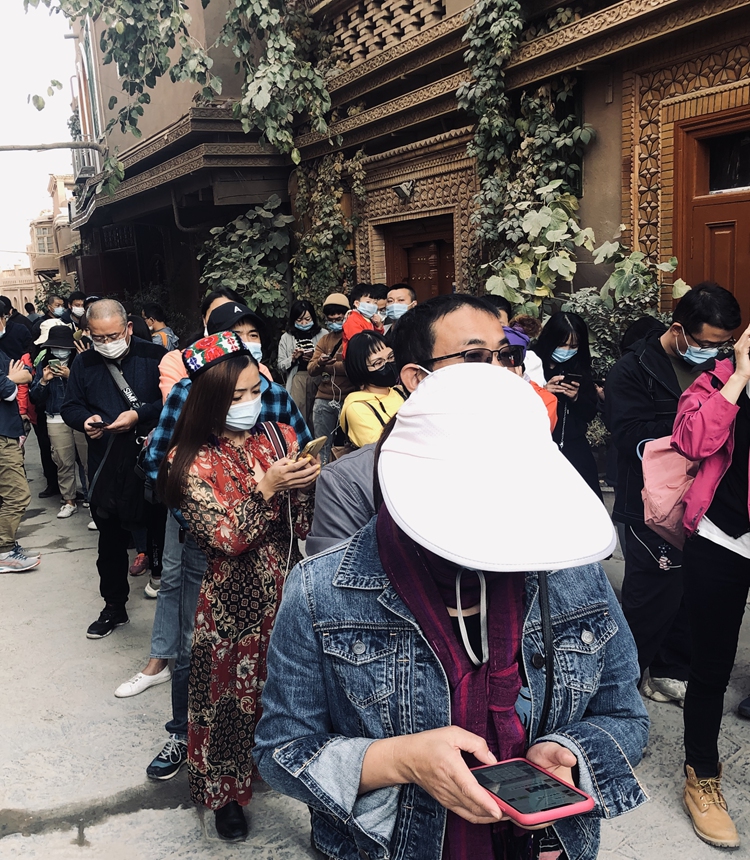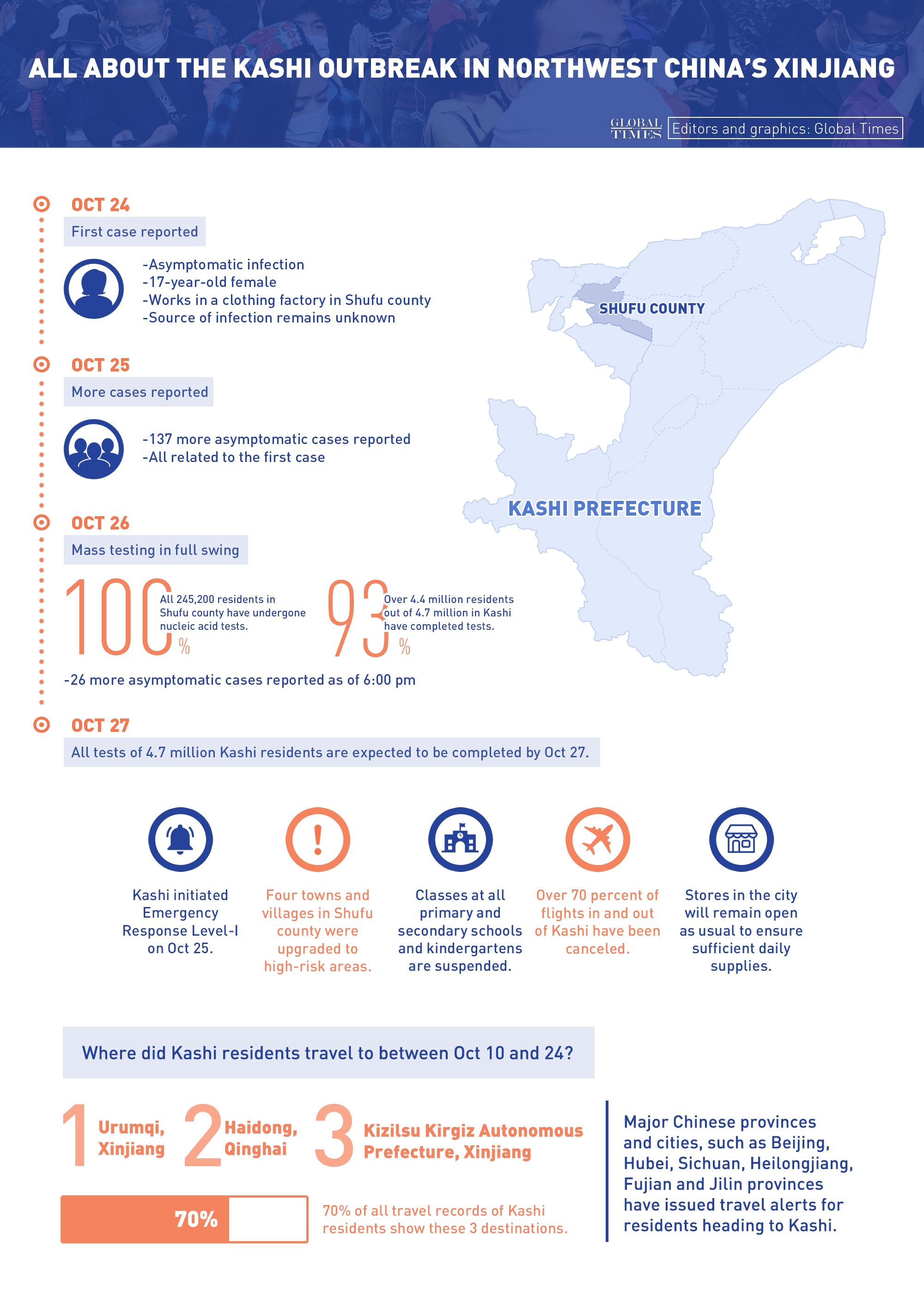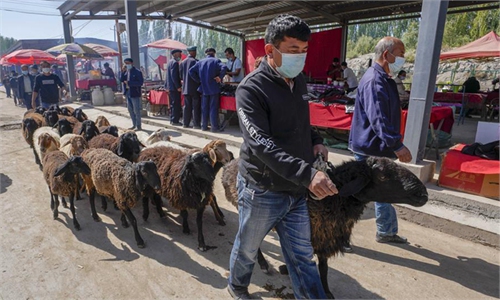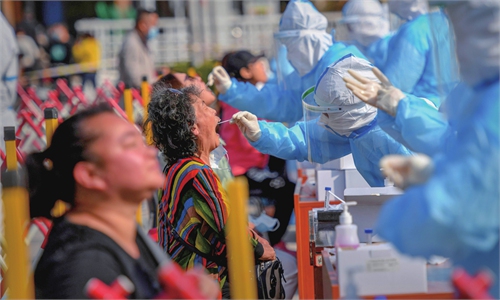Kashi returns to quasi lockdown after virus spike
Precise response minimizes influence of epidemic

People are queuing to take nucleic acid tests in the old town of Kashi, Northwest China's Xinjiang Uygur Autonomous Region, on Saturday. Photo: VCG
The sudden spike in coronavirus infections in Kashi prefecture, Northwest China's Xinjiang Uygur Autonomous Region brought the region back to a quasi lockdown mode, where one in five residents are undergoing nucleic acid tests, and many businesses were closed, and classes were suspended. But the source of the infections remains a mystery.
Local authority said on Monday's press conference that Shufu county under Kashi reported 26 new asymptomatic COVID19 patients as of 4 pm.
Chinese experts reached by the Global Times believe that the 164 asymptomatic infections were discovered before they showed any serious symptoms, which could be seen as a good sign.
In the wake of the epidemic outbreaks in Beijing, Qingdao as well as Urumqi, Kashi - the westernmost border region of China - are copying previous experiences by taking more precise epidemic response measures in the prevention and control work to minimize the impact of the outbreak on local people.

Infographic: GT
Mysterious 'patient zero'
While the cause and source of the infections have not yet been identified, medical experts based in Xinjiang said the asymptomatic patients will be given viral sequence tests to help track "patient zero."
The range of human activities is limited, and one novel coronavirus patient could infect an average of three people. The 164 cases means that there could have been a second, third, or even more generations of infectious cases, and "super spreaders" cannot be ruled out, said Wang Guangfa, a leading Chinese respiratory expert at Peking University First Hospital in Beijing.
Shanghai-based epidemiologist Jiang Qingwu agrees. Jiang told China Newsweek Magazine that the 17-year-old woman who was the first patient to be discovered in Kashi is more like a third-generation patient. All nucleic acid tests at a clothing factory where she works were negative, but the COVID-19-positive cases were from the factory where her parents work.
Anti-body tests could be another good way to help track patient zero, he said.
Other Chinese experts believe it is necessary to trace the original source of the infections, and find out whether the source began with imported cases or cold-chain food or other causes.
To further track the source of infections and patient zero, Zhang Yuexin, a medical expert who is part of Xinjiang's anti-epidemic group that is giving guidance to medical treatment in Kashi, told the Global Times on Monday that these patients will be given viral gene sequencing tests.
After Xinjiang's official report revealed that the cases were linked to a factory in the county, some foreign media and journalists started to fabricate stories to defame Xinjiang, accusing the factory of being a so-called forced labor camp, which Zhang dismissed as groundless.
In talks with patients in Kashi, Zhang learned that they come from a clothing factory in Shufu county as a part of the government's poverty alleviation campaign. Most of those infected are young and middle-aged women, aged between 20 and 55 years old, Zhang said.
Some asymptomatic patients in Kashi have started to show mild symptoms in hospital. Zhang said they are under sufficient medical treatment.
Medical experts said this is a good sign, as it means the outbreak is still in the early stages of transmission, winning more time for the government to do epidemiological investigations and virus prevention and control.
While a team of experts from the National Health Commission was sent to Kashi, the city is ramping up efforts for citywide nucleic acid tests, aiming to cover all 4.7 million residents as of Tuesday.
As the westernmost border city of China, the Kashi region is an important gateway to the west, bordering Tajikistan, Afghanistan, and Pakistan.
It is no surprise to see a city with dozens or even hundreds of COVID-19 cases, while China has basically controlled the virus but still faces challenges brought about by overseas infections, Yang Gonghuan, former vice director of China's CDC, told Sichuan-based media Red Star News on Monday.
"Two waves of infections occurred in Xinjiang and are sporadic. Such outbreaks could happen anytime, but China will not go through another severe epidemic like [that in] Wuhan."
Precise response mechanism
When an epidemic broke out in Urumqi, the regional capital city of Xinjiang, in August, people were impacted by the strict 40-day lockdown that caused inconvenience and economic loss. This outbreak in Kashi, however, is a more precise response mechanism because only four high-risk epidemic counties in Shufu county, where the 164 cases are located, were locked down, while Kashi remains open, the Global Times learned.
Zhang told the Global Times that "the precise responding mechanism would minimize the influence of epidemic on people's lives to its lowest."
While Kashi remains open to tourists, with no nucleic acid reports required to enter the city, pedestrian traffic was largely reduced on Monday, locals said. Residents and tourists chose to stay indoors.
Classes at all kindergartens, elementary and high schools were suspended until October 30, said the Kashi local anti-epidemic group.
But the official requirement of a negative nucleic acid test to leave the city has stranded many tourists.
Yang Zi, a tourist from Central China's Anhui Province, had to receive another nucleic acid test to travel to Urumqi.
"I saw many stranded tourists like me in the First People's Hospital of Kashi on Monday morning waiting to undergo nucleic acid tests," Yang said, "Only a negative test report would free us from Kashi"
The first reported silent virus carrier was reported in Shufu county, which is about 15 kilometers away from the Kashi city center. It is a multi-ethnic settlement county composed mainly of Uygurs and 13 other ethnic groups, including Han, Kirgiz, and Tajik.
The Global Times learned from villagers from the four villages under Shufu county which were labeled as high risk of COVID-19 epidemic by the State Council on Sunday that the regions are dopting quasi-lockdown measures.
"We were told to stay at home. Volunteers would deliver food to us," a villager from Shufu county told the Global Times on Monday.
Several other restaurants owners in Shufu county told the Global Times that businesses at all restaurants in the county were suspended as no one is allowed to step out of their residential communities for now.
An official report said the Kashi region has activated Emergency Response Level I after the city reported 138 asymptomatic cases -meaning, the local government is empowered to suspend large gatherings, classes and activities.
As a preventive measure, major Chinese provinces and cities, such as Beijing, Hubei, Sichuan, Heilongjiang, Fujian and Jilin provinces, had issued travel alerts to Xinjiang's Kashi, and Kashi travelers will be given nucleic acid tests when they arrive.
In October, Kashi has good views of snow-capped mountains and meadows, widely reviewed as a golden season for tourism. During this year's National Day holidays, the Kashi region received over 2 million tourists, a 122 percent increase from last year, official data shows.




